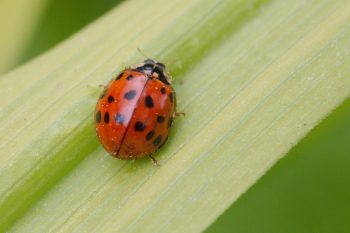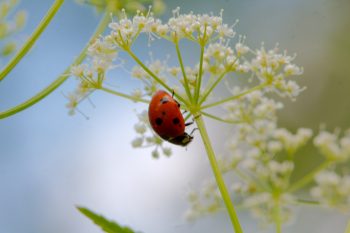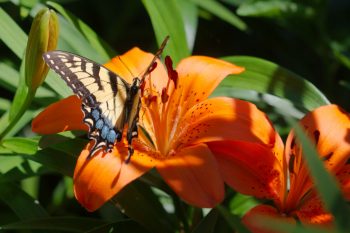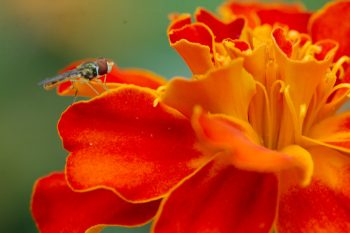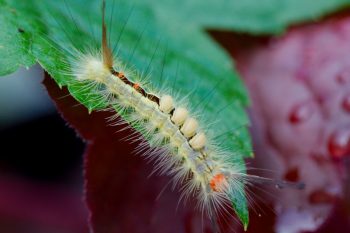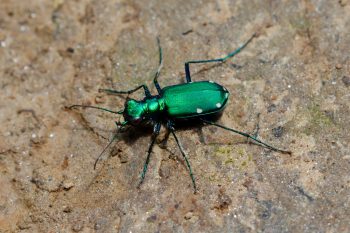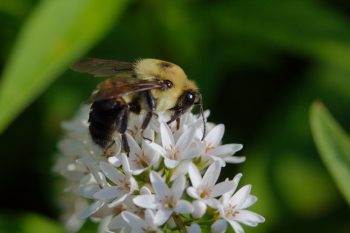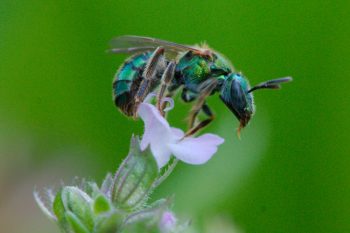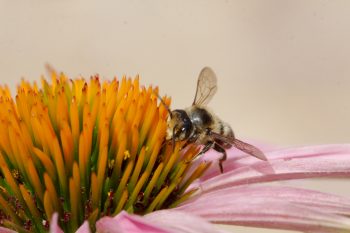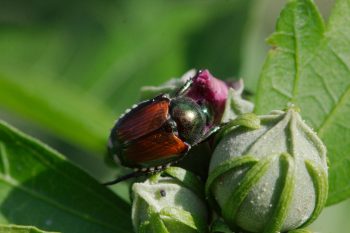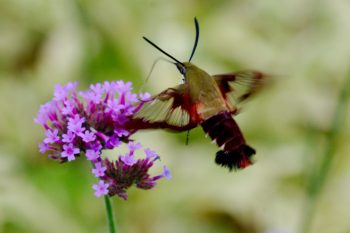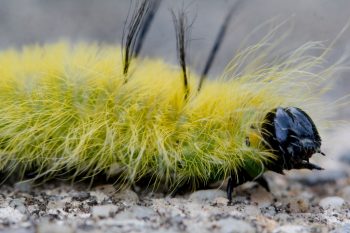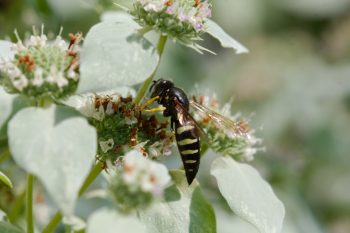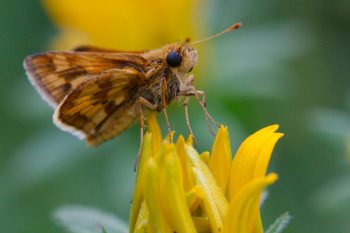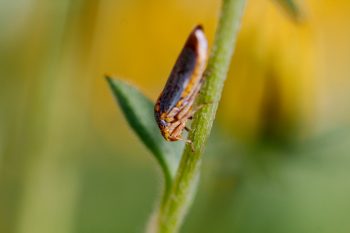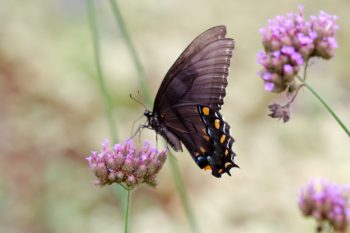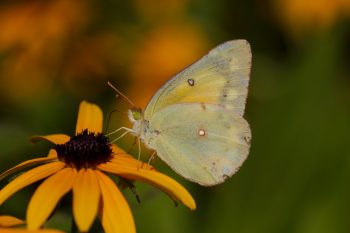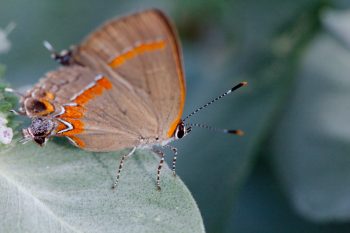I haven’t included the specific name for this lady beetle in my title because I’m not entirely sure what it is. My guess would be that it’s an Asian lady beetle (Harmonia axyridis), though as they are quite common and this certainly looks right. But I’m no expert. I got one photo of this on a leaf before it flew away so although it isn’t as sharp a picture as I’d like, it’s all I have. These are, of course, insects that we like to have in our garden, as they eat aphids. I haven’t seen aphids in great numbers in the garden yet this year but they’ll be along before too long, have no fear. That and Japanese beetles are the two insect pests I see the most in the summer months.
Tagged With: Insecta
Lady Beetle
Asian Lady Beetle (Harmonia axyridis)
I took some photos of some yellow flowering sedum this afternoon but they didn’t turn out very well. You’d be stuck with them except I happened to see this Asian lady beetle (Harmonia axyridis) on a stem and got down on the ground to get a few photos of it. This plant has a flower cluster similar to Queen Anne’s lace but that’s not what it is. It’s a very aggressive weed that we picked up somewhere along the way and we really need to do something about it. But it made for a nice photograph, in this case. It may be Chaerophyllum aromaticum but I really don’t know. Whatever it is, you really don’t want any.
Tiger Swallowtail (Papilio glaucus)
We had our first sighting of a tiger swallowtail (Papilio glaucus) today and it was nice enough to perch on the Asiatic lilies growing in our front garden. I’ve actually seen a few butterflies around but haven’t had a chance to get any photos. Soon we’ll have them in abundance, especially when the Buddleia starts to bloom. These Asiatic lilies are surrounded by tiger lily plants (Lilium lancifolium), which are considerably taller and I’m not sure these can get the attention they deserve. On the other hand, this makes them harder for the deer to get to, which is a plus.
Syrphid Fly on Marigold
I went out to take some pictures of flowers today. There are a few sitting on a table that I set up for Cathy to work on and that seemed like a nice place to sit and take pictures. I took some of a coral bells plant (Heuchera x ‘Blondie’) and then I noticed this syrphid file (Family Syrphidae) on a marigold blossom. There’s only so close I can get with my 100mm macro and I’d like some way to get closer. I’ve thought about buying a Canon MP-E 65mm f/2.8 lens that gives magnifications of 1 to 5 times, basically picking up where my current lens leaves off. It’s manual focus, but at that close range, focus is as much a matter of moving the camera closer or further away from the subject.
White-marked Tussock Moth (Orgyia leucostigma)
I was sitting outside this morning, taking a break from doing some yard work, when I noticed this caterpillar on the tire of my car. I moved it to a plant, figuring it would be shown to better effect there than on the black tire, and then I got my camera and took a few photos. It is a white-marked tussock moth (Orgyia leucostigma), a species native to our region. Interestingly, the adult females are wingless and therefore flightless. If you find one of these, you’ll want to avoid handling it with your bare hands. Its hair is known to cause allergic reactions, especially in areas of the body with sensitive skin. I let it crawl onto a leaf to move it, so as to avoid any issues.
Cicindela sexguttata (Six-spotted Tiger Beetle)
Cathy and I went on a new trail today. I don’t know if the trail is actually new but it was new to us. We walked in the Rock Creek valley between Muncaster and Muncaster Mill Roads. As the crow flies, it’s probably a mile from end to end. The trail winds quite a bit and there’s a bit of up and down and based on a map we found, it’s more like 2.5 each way. So, about five miles. It was pretty hot and very humid, but we really enjoyed the green and also the birds that were supplying the background chorus most of the way. We saw quite a few of these six-spotted tiger beetles (Cicindela sexguttata) as well as ebony jewelwings (Calopteryx maculata), a damselfly with black wings (except for on females there is a conspicuous white spot at the end of the wings.
Common Eastern Bumble Bee (Bombus impatiens)
Pretty much all the flowers in our garden are attractive to insects. I suppose that makes sense, because that’s what flowers are supposed to do, in order to get the insects to (inadvertently) pollinate the flowers. It’s interesting to me, though, that some flowers are attractive to many different insects but some seem to attract a specific subset. Yesterday, I was looking at the Monarda (bee balm) and noticed that the large bees were almost exclusively carpenter bees (Xylocopa virginica). Today I was looking at the gooseneck loosestrife (Lysimachia clethroides) shown here and the large bees were exclusively common eastern bumble bees (Bombus impatiens). Just interesting, that’s all.
On a mostly unrelated note, I really, really don’t recommend you plant any Lysimachia species in your garden. The bees love it, but there are other things they like that aren’t so overwhelming.
Green-Sweat Bee
I was out with my macro on a 25mm extension tube this evening and got a few decent photos of this green bee. I labeled it a cuckoo wasp at first, but now I’m thinking it’s a green-sweat bee (Tribe Augochlorini). But don’t hold me to that. If I get a better identification, I’ll update this post. For now, all I can say for sure is that it’s a bee (Anthophila). I can also say that it’s quite pretty. It was moving around quit a bit and this was the best I could do at ISO 800, f/8, 1/100 second.
Resin Bee on Coneflower
I wasn’t happy with most of the pictures I took today, but this one isn’t too bad. I’m pretty sure this is a sculptured resin bee (Megachile sculpturalis), although there are a few other Megachile species it could be (e.g. the flat-tailed leaf-cutter bee, Megachile mendica, which is more common). Regardless, it’s a nice, quiet little bee and it was moving among the coneflowers, along with a few other solitary bees and an occasional honey bee (Apis mellifera). I know that some folks are not fond of bees and don’t like to have them around. With the exception of a few aggressive hornets and wasps, I like having them around. They really rarely sting unless provoked and they are quite pretty to watch on flowers.
Popillia japonica (Japanese Beetle)
I am definitely not a fan of the Japanese beetle (Popillia japonica), a native of (unsurprisingly) Japan, and instroduced into North America in the early 20th century (first found in the United States in 1916 near Riverton, New Jersey). They are quite destructive of a wide variety of plants, including both ornamental plants (like roses, which they love) and agricultural crops (soybeans, stone fruits, etc.). Their larvae damage lawns, feeding on the roots of grasses. They are, of course, pretty if you can disassociate them from the destruction they cause. But that’s hard for me to do and I don’t really have a lot of sympathy for them. This one is on a rose of Sharon (a.k.a. shrub althea, Hibiscus syriacus).
Snowberry Clearwing (Hemaris diffinis)
After we got home from visiting mom this afternoon we were sitting in the front yard. The evenings have been warm but so much nicer than it’s been during the heat of the day. Because my work setup is in the basement, I feel like I need to get outdoors some each day so I’m going out front after work to read. Today wasn’t a work day, but I sat out anyway. I had just taken a photo of the tiger lily buds when we spotted this snowberry clearwing moth (Hemaris diffinis) on the Verbena bonariensis. I didn’t really have great light for taking pictures of a moth on the wing (and these rarely land, preferring to hover). But this one turned out pretty well, I think.
Sneezeweed (Helenium ‘Mardi Gras’)
Cathy bought a few perennials over the weekend and I planted this one yesterday. It’s a sneezeweed called ‘Mardi Gras’ and it’s really nice. The flowers have a similar look to black-eyed Susans but it’s a different genus (Helenium). I happened to catch it with a little, green-sweat bee on it, which is a bonus. It prefers somewhat barren ground and isn’t supposed to do well in heavy clay, which is probably why I haven’t seen it around here. That’s really all we have. But hopefully it will survive, even if it doesn’t thrive too well.
American Dagger Moth Caterpillar (Acronicta americana)
Cathy called me up from the basement this morning because she thought I might like to see this caterpillar on our back patio. It was crawling along the hose but then moved off onto some leaves and sticks, which looks a bit more natural. It is an American Dagger Moth Caterpillar (Acronicta americana). They feed on the leaves of various deciduous trees so I really shouldn’t have let it live, but I did. Apparently the hairs can cause skin irritation, so it’s something you probably don’t want to handle. I didn’t, so I cannot say whether or not it’s a serious problem.
Bicyrtes quadrifasciatus
This is a sand wasp, Bicyrtes quadrifasciatus I believe. It’s fairly common although nothing like the western honey bee or the bumble or carpenter bee, but I see them quite a bit on the mountain mint (Pycnanthemum muticum), as this one is. If I go out in the heat of the day, with the sun beating down on the mountain mint, it’s an absolute hive of activity (and I mean that in the most literal sense). There are myriad bees and wasps buzzing around with an occasional skipper sneaking in. The buddleia above has mostly bumble and carpenter bees as well as butterflies. Now and then I spot a true bug of one sort or another. It’s really wonderful, unless of course you are allergic or simply afraid of stinging things. It’s also very hot so I don’t generally stay out too long, but I love it.
Polites peckius (Peck’s Skipper)
The skippers are here in their great numbers. They aren’t flashy like the swallowtails and they don’t buzz like the bees, but they are everywhere. They especially like the black-eyed Susan flowers (as seen here) and the Verbena bonariensis but they can also be seen on other plants. This is, I believe, a Peck’s skipper (Polites peckius), also known as the yellow patch or yellow spotted skipper. The larvae feed on grasses while the adults take nectar from flowers. They are widespread across much of North America.
Monarch on Butterfly Weed
The monarch (Danaus plexippus) is one of the prettiest butterflies we get. They don’t show up in nearly as great numbers as do the tiger swallowtails (Papilio glaucus) and maybe that’s what makes their appearance more exciting. This one was on a tender butterfly weed (Asclepias curassavica) that it in a container on our back patio. I took this one photo from the lawn side of the patio before trying to get around to the other side. Just as well because it flew off after that and I got no more. I did take some more photos of the tiger swallowtails but I’m sure I’ll get more of them this summer.
Oncometopia orbona (Broad-headed Sharpshooter)
I took some photos of flowers today as well as a few of tiger swallowtails. But then I saw this little insect. It’s a leafhopper and they aren’t very big. I got two decent photos of it, one with the head and eyes in focus (this one) and the other with the body in focus but the head blurred. Nevertheless, it was enough to let it be identified as a Broad-headed Sharpshooter (Oncometopia orbona). There are four species of Oncometopia in the U.S.A. but this is the only one that’s known to be present here, so I’m pretty sure that’s right. It’s a pretty little critter.
Tiger Swallowtail (Papilio glaucus)
We have a lot of tiger swallowtails (Papilio glaucus) in our yard. The particularly like the butterfly bush (Buddleia) but we see them on other flowers, as well. They are often quite ragged, with torn wings and sometimes with less than half remaining. Nevertheless, they seem to get around alright. Most of them are the standard yellow striped with black but we have a significant number of the dark form, which is restricted to females of the species. This is a pretty nice one, with her wings mostly intact. As you can see, she is on a tall verbena (Verbena bonariensis).
Orange Sulphur
I’m not actually 100% sure of the identification of this sulphur. It may be an orange sulphur (Colias eurytheme) but it’s hard to tell for sure from the underside of the wings. It’s a sulphur, anyway, subfamily Coliadinae. I’ve had a hard time getting a good photograph of one, as they are quite shy and often don’t land when I’m near by. So, I was pleased to get this photo and a few others today. It’s a pretty little butterfly and I love seeing them on the flowers in the yard.
Calycopis cecrops (Red-banded Hairstreak)
This is a pretty little butterfly that I don’t see too often in our yard. It is, I believe, a red-banded hairstreak (Calycopis cecrops). It was moving about amongst the mountain mint (Pycnanthemum muticum) and that made it hard to get a clear photo of it, but this one turned out pretty well. The hairstreaks are a subfamily (and considered as a tribe) under the Lycaenidae, the Blues, Coppers, Hairstreaks, and Harvesters. They are smallish butterflies and their “eye spots” at the far end of their hind wings presumably fool prediters into thinking that’s their head enough to improve their chance of survival.

